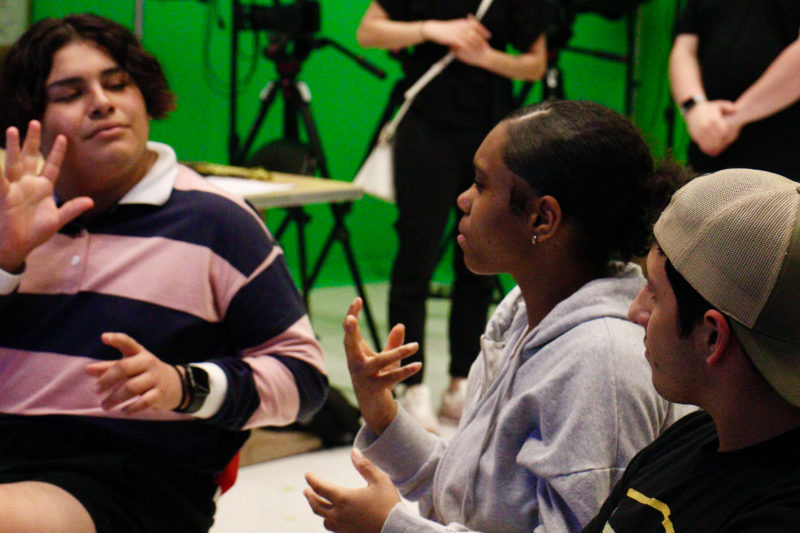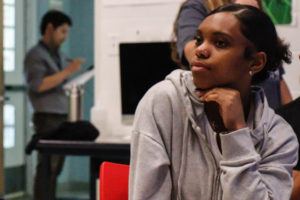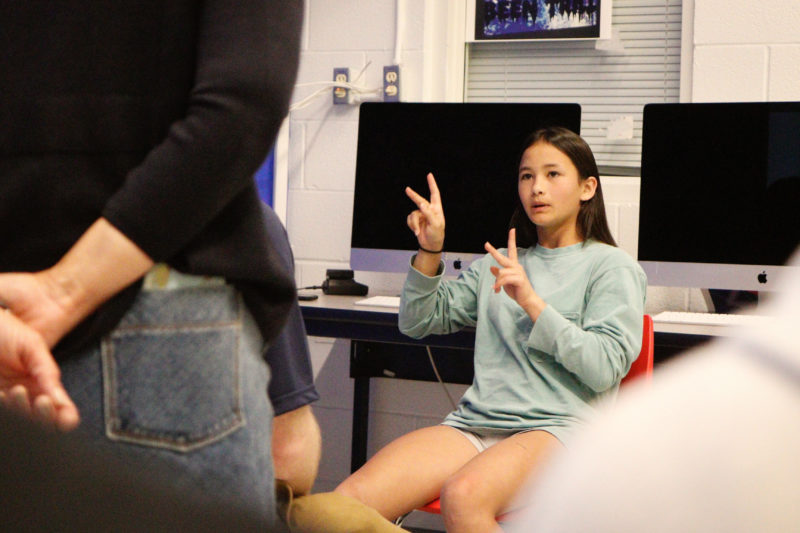Acclaim for ‘CODA’ a Sign that Times Are Changing for the Deaf Community
By Marina Garcia
Reporting Texas

From the left, sophomore Frankie Ramirez, senior Kourtney Dolloile and senior Aiden Magana sign to one another during their theater class at the Texas School for the Deaf on March 31, 2022. Sloan Wyatt/Reporting Texas
Kourtney Dolliole, 18, learned the film “CODA” won at the 94th Oscars while scrolling through Instagram the night of the award show and was shocked that Troy Kotsur, a deaf actor, won best supporting actor for his role in the movie.
Dolliole, a senior at the Texas School for the Deaf in Austin, hopes acclaim for “CODA” is just the beginning for better representation of the deaf community and opens the door for more opportunities for deaf individuals in the film industry.
“I hope this educates people (on) what deaf people can do, not just as actors, but in different roles … behind the camera, and seeing that deaf people have that ability and are hiring and giving (those) opportunities,” Dolliole said.
“CODA,” written and directed by Sien Heder, won three Oscars: best picture, best adapted screenplay and Kotsur won best supporting actor.
Produced and streamed by Apple TV, the film tells the fictional story of Ruby (Emilia Jones), who is a hearing-abled child of deaf adults, or CODA. “CODA” depicts the struggles Ruby faces as being the sole interpreter for her family while also trying to gain her independence and pursue her passion for singing.
“CODA brought out the unique experiences of deaf families that have hearing children and shared this common story with the American public for the first time,” CEO of the National Association of the Deaf Howard Rosenblum said in a statement to Reporting Texas.
What sets “CODA” apart from other movies is the number of deaf actors in the film, Dolliole said.
“It’s always been like one deaf person (in a film) … so it’s nice to see the three actors in one movie,” she said.

Senior Kourtney Dolloile, a student at the Texas School for the Deaf, poses while hanging out with her peers in a theater class on March 31, 2022. The students were being interviewed by press after the movie “CODA,” which features three deaf actors, won three Academy Awards. Sloan Wyatt/Reporting Texas
Deaf actress Marlee Matlin won the Academy Award for best actress in 1987 for “Children of a Lesser God” but said her experience playing Ruby’s mother in “CODA” was different from previous projects. She said in an interview with PBS that the cast and crew used American Sign Language to communicate, and she helped cast Kotsur in the role of Ruby’s father..
“The NAD applauds directors like Sien Heder who consulted with Marlee Matlin and decided to only hire deaf actors to portray deaf roles in ‘CODA’,” Rosenblum said.
That was a groundbreaking and welcome change, Rosenblum said.
“For too long, the industry has rewarded actors and directors who have exploited the trope of faking sympathetic disabilities to win awards for themselves without bringing in deaf people or people with disabilities to ensure authenticity,” Rosenblum said.
Wilmonda McDevitt, director of student life at the Texas School for the Deaf, recalled watching the film with her two sons, who are CODA themselves.
“I wanted their perspective,” McDevitt said. “We would watch and pause and have discussions and they really related to the movie a lot. It really reflected deaf culture.”
McDevitt noted that in the film the only hearing member of the family acts as an interpreter for her parents and brother. But McDevitt said that’s something most deaf families don’t do.
When it comes to her sons, there are instances where she allows them to interpret for her, but “I’m not going to rely on them,” McDevitt said.

Kaylee Hottle, a seventh-grade student at the Texas School for the Deaf in Austin, answers interview questions about the 2021 movie “CODA.” Sloan Wyatt/Reporting Texas
Others have criticized the movie for not showing other means of communication deaf individuals might use instead of an interpreter, such as using video, reading lips or communicating with pen and paper, The New York Times reported.
School for the Deaf video production teacher Janis Cripps wasn’t a fan of the vulgarity of the sign language used by Krotsur’s character and doesn’t want the hearing audience to think all deaf people are like that.
“I’m proud of my cultural representation, but it doesn’t mean that (the character) fits me to a tee,” Cripps said.
While Rosenblum applauds the film’s representation of a deaf family, he said it shows only a small portion of the deaf community.
“CODA is an excellent film for hearing people to watch and learn a few things about deaf culture with the understanding that it is a fictional movie,” he said.
The film can be a great starting point for the hearing community to educate themselves about the deaf community, School for the Deaf senior Zoe Rarus said. rat
“People that can hear should learn about deaf people and show more recognition (by) learning sign language and become aware of what the community looks like,” Rarus said.
McDevitt was surprised how the crowd and presenters at the Oscars used American Sign Language to make the deaf actors — and the deaf community — feel welcomed during the award show by signing their applause when Kotsur won.
“That really just gave me goosebumps, that extra effort,” McDevitt said.